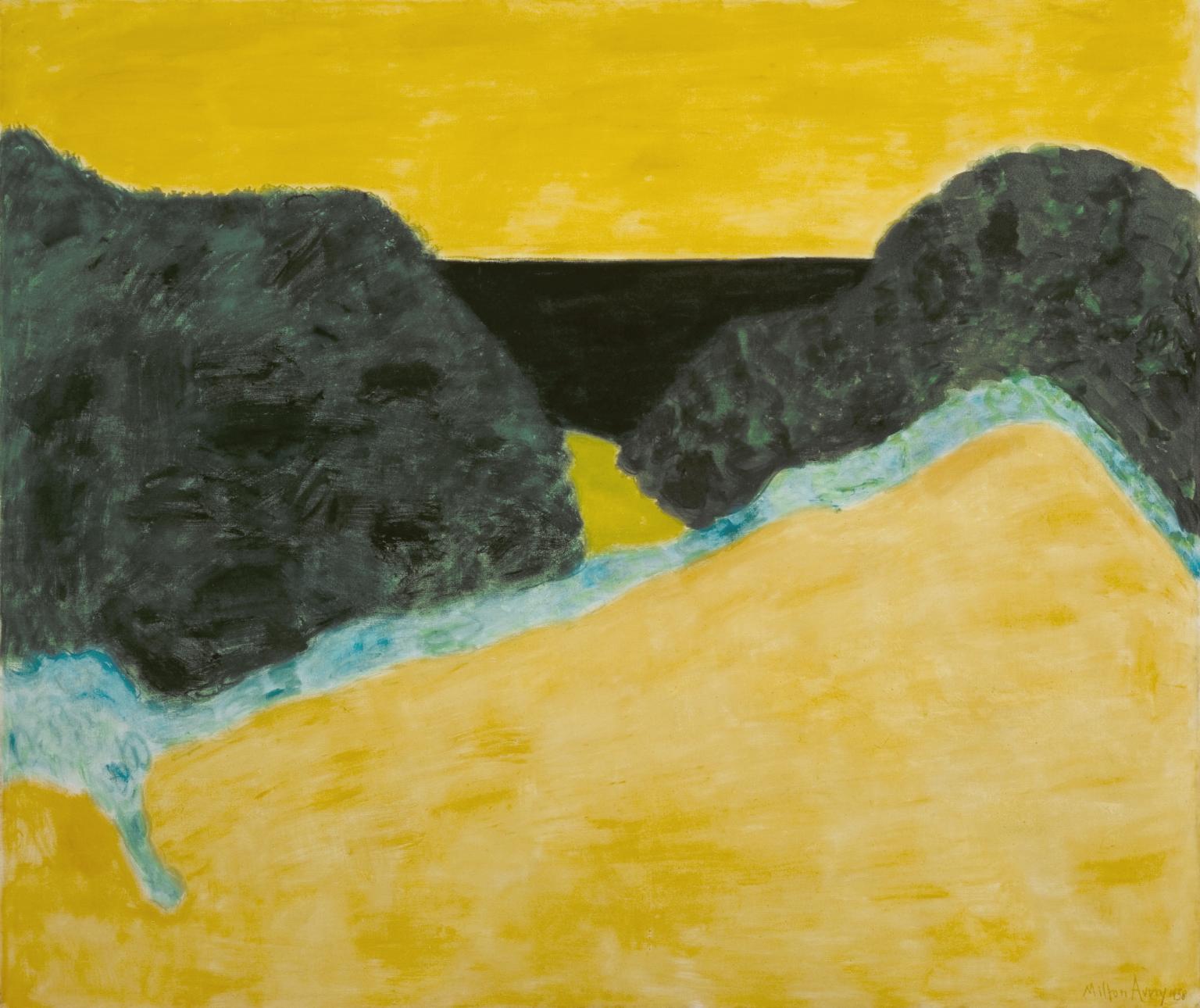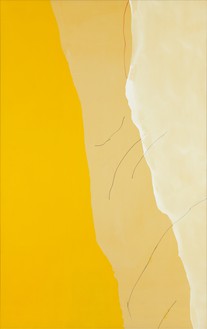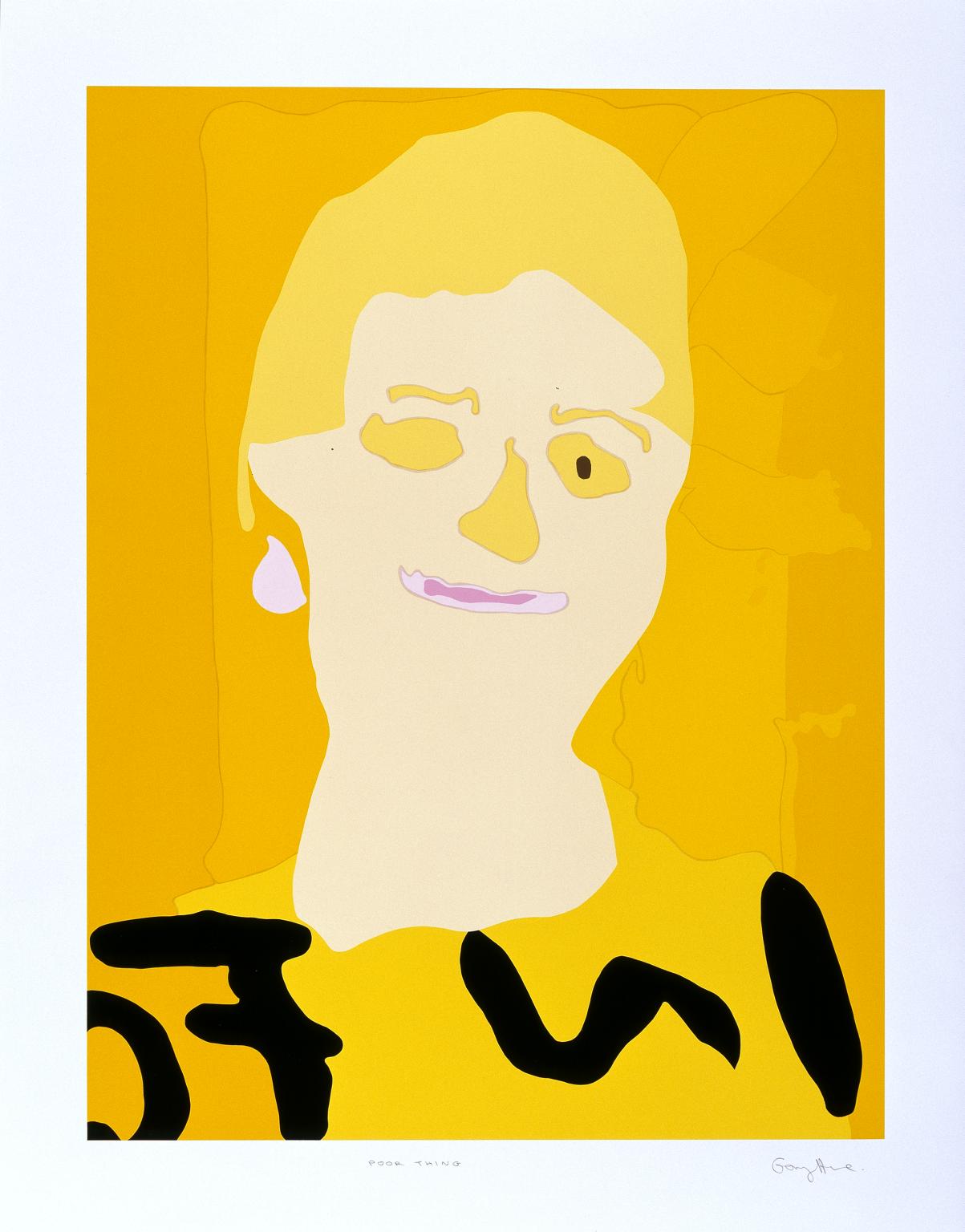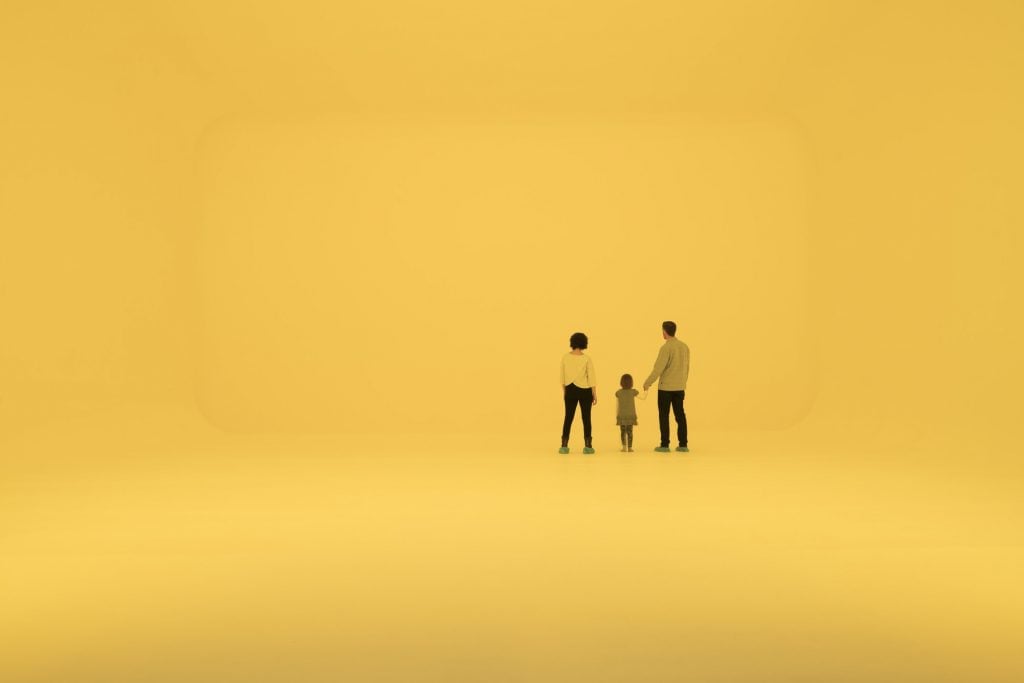With the lines “...and it was all yellow,” Chris Martin from Coldplay sings about the beautiful feeling of deep friendship and devotion. After all, yellow stands for sun, warmth, light, for an endless summer, and feelings of happiness, for the broadly grinning smiley. We associate the color with the glistening, direct sunlight, which is why pure yellow is attributed an incredible radiance and long-distance effect. The spectrum of individual associations and interpretations is as broad as the nuances of the color. This is also shown by the following 10 works in which yellow plays a central role.
Milton Avery, Yellow Sky, 1958
Is a storm brewing? Or is it the setting sun that has colored the sky yellow? We don’t know what spectacle of nature Milton Avery witnessed. What we do know for sure is that his work “Yellow Sky” was inspired by sketches and water colors that he produced in the summers of the late 1950s in Provincetown, Cape Cod. On returning to his New York studio, he worked the scenes up into compositions which he then greatly reduced in form and color. “Yellow Sky” depicts an abstract interpretation of the landscape in which the color yellow clearly dominates. The deep yellow strip in the upper half of the picture – the “yellow sky” in the title of the work – is complemented by a much larger expanse of yellow in the painting’s lower section. The monochrome effect is broken up by dark gray rock formations and a light blue watercourse. For although much of Avery's painting is reminiscent of the works of the abstract expressionists, the artist has ultimately never devoted himself to complete abstraction.
.

Milton Avery, Yellow Sky, 1958, Image via: tate.org.uk
James Casabere, Bright Yellow House, 2018
The “Bright Yellow House” is part of the series “On the Water’s Edge” by American artist James Casabere. In the staged photographs he focuses on issues relating to climate change and impending environmental catastrophes. His scenes are both deeply ambiguous and politically biting: The images of uninhabited spaces and landscapes appear surreal and come across as deeply disturbing. Casabere's hybrid architectural structures combine public space with private sanctuaries, which he locates on and in the water. In this series of images, the artist continues his ever-evolving research into shapes on the thin line dividing architecture, sculpture, and photography. The photographic tableaus he shoots in his studio testify to a mastery he has perfected over the past 40 years.

James Casabere, Bright Yellow House, 2018, via: www.jamescasebere.com
Helen Frankenthaler, Mornings, 1971
Rays of sunlight breaking through the gray morning light: This could be an apt description of the panting by Helen Frankenthaler. Three vertically running yellow color fields decrease in intensity towards the right and seem to blur. The areas are accentuated by individual strokes that appear to be randomly placed. In her work Frankenthaler repeatedly explores the relationship between drawing and painting. In the 1970s, the artist introduced more open drawing elements such as the thin lines described above that cut through the colored contours.
A line, a color, a shape, a space, they all do one thing for and in themselves, and yet they do something else, in relation to everything that goes on within the four sides [of the canvas]. A line is a line, but it is also a color.

Image via: gagosian.com
Lubaina Himid, Ankleedeep, 1991
Two women stand ankle-deep behind cloth banners and tear up maps, scraps of which drift away. This is how Tanzanian-born British artist Lubaina Himid describes “Ankledeep”, a work from the series “Revenge. A Masque in Five Tableaux.” The series comprises 12 works that often depict pairs of black women in a range of scenarios. The nakedness of the two women in “Ankledeep” is partly covered by a black banner lending them a certain dignity. A golden yellow ribbon frames their heads. Though attentive they look calmly at something hidden from us to their left. Scraps of paper fall from the hand of the right figure and are borne aloft by the wind. These are fragments of a torn-up map, an action interpreted here as an act of revenge: The women shred and scatter the colonial maps of the past before setting off in search of new ways and garments. The historical narrative of migration and colonialism continually finds its way into Himid's paintings, installations, works on paper, and woodcuts. The focus here is on the cultural status of black women.

Image via: tate.com
Gary Hume, Poor Thing, 1998
This picture impressively demonstrates that the color yellow does not only stand for the positive aspects of life. In the silkscreen “Poor Thing” we see the strangely deformed face of a person whose supposed plight is symbolically expressed by mismatched eyes and confirmed by the title. We do not know who this person is. It is an imaginary figure composed of different yellow color planes. The portrait is the sixth of ten silkscreen prints in the “Portraits” series by British artist Gary Hume and based on paintings that he created between 1994 and 1998.

Image via tate.org
James Turrell, Perfectly Clear (Ganzfeld), 1991
When you think of monumental worlds of color, one artist who simply cannot be ignored is James Turrell. The pioneer of the Light and Space Art movement creates immersive works that envelop the viewer in a cosmos of color and light. When standing, sitting or lying in the light installation, you are completely surrounded by the yellow atmosphere. A feeling of disorientation sets in, while at the same time you have the sensation of floating. And indeed, the installations are designed to eliminate depth perception and dissolve physical boundaries. James Turrell invites us to block out the outside world and to reflect on ourselves.

Image via: news.artnet.com
Hayv Kahraman, Concealed Weapon, 2016
Hayv Kahraman understands her own body as a form of language. For the artist, who fled from Iraq, the body became her medium in her search for a common denominator during her exile in Sweden, Italy and the United States. Women with pale skin and jet-black hair take center stage in her large-format paintings on linen panels. Her figures are reminiscent of Italian Renaissance paintings as well as Persian miniatures or Japanese illustrations. As such, she succeeds in bridging the gap between Eastern “exoticism” and Western concepts of beauty. The nude woman in “Concealed Weapon” holds a cloak, a stole in her hands made of an geometric Islamic pattern in yellow. Not only is Kahraman's work directly intertwined with the history of the Iran-Iraq and Gulf wars, but also with the cultural memory of the diaspora.

Image via: hayvkahraman.com
Leni Hoffmann, Sansibar, 2012
This is not a sentence that real art lovers like to hear. But in this case, one can perhaps forgive this clichéd question... Because at first glance, it really does look as if construction workers had forgotten the electric cables in the middle of the exhibition space after their work was done. However, if you take a closer look at “Zanzibar”, you will notice that the loops lie surprisingly evenly on the floor. The two yellow cables seem to come out of the ceiling and lie in loops on the floor, not overlapping. Leni Hoffmann's site-specific work is a “spatial drawing” with a specific underlying concept.
Is that art, or can it go?

[Translate to English:]
Image via: staedelmuseum.de
Joseph Beuys, Capri Battery
“Replace after 1000 hours” reads the inscription on the wooden box of the 1985 multiple “Capri Battery” by Joseph Beuys. The combination of light bulb and lemon shows nature as a source of energy. It is constantly changing and resembles a self-charging battery. At the same time, the multiple brutally shows us how fragile our ecosystem is today – and how limited natural resources are, so that we have to be all the more sparing with them. Beuys' understanding of art, which is characterized by a deeply felt connection to nature, is particularly evident in the “Capri Battery” Incidentally, the prototype of the work was created during one of the artist's convalescent stays on Capri.

Image via: faz.net
Ugo Rondinone, pure sunshine
Pulsating, vibrating, oscillating: Ugo Rondinone's eight suns cast a spell over the visitors. They illuminate the last room of the “LIFE TIME” exhibition at the SCHIRN and envelop it in radiant yellow. The circular canvases are sprayed with concentric yellow rings and their arrangement in the room is reminiscent of a solar composition. The bands of yellow, whose melting edges call to mind a heat haze, reflect a number of themes that Rondinone has explored throughout his creative career: day and night, light and darkness, yesterday and today.
